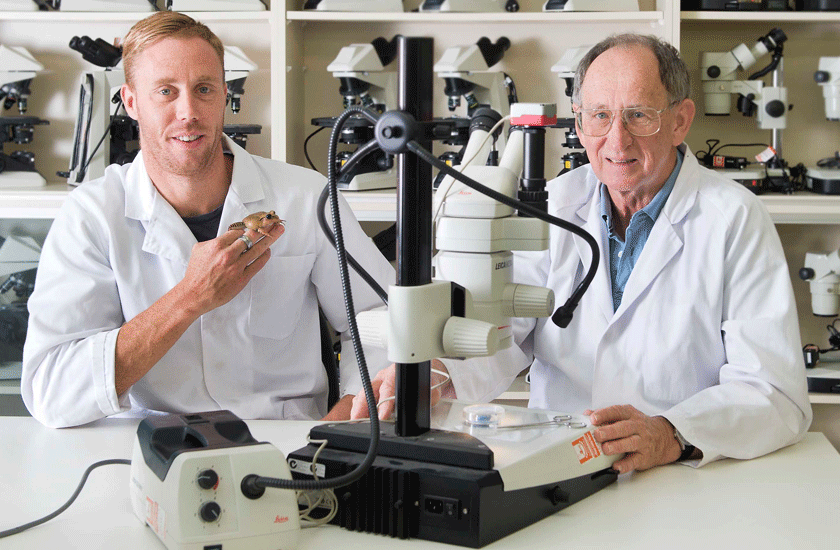Gastric Brooding Frog
University of Newcastle researchers are responsible for one of the world's most significant inventions of 2013, according to TIME Magazine's 25 Best Inventions of the year 2013, just released.

The Lazarus Project has developed de-extinction technology which will resurrect vanished species and is the only Australian invention named in the global list.
The breakthrough genome technology, which has been successfully applied to the gastric brooding frog, extinct since 1983, could herald a new era in global biodiversity and conservation management.
In its introduction to this year's list, TIME said, "What makes an invention great? Sometimes it solves a problem you didn't think could be solved. Maybe you didn't realise you needed to resurrect an extinct frog. Now you do."
The resurrection of the gastric brooding frog may also have implications for the medical world.
"The gastric brooding frog swallows externally fertilized eggs into its stomach, which then operates as a uterus. No other living creature can do this. This unique ability could help the medical world work out how to manage gastric secretions in the gut," said Michael Mahony, Project Leader, Professor of Biology at the University of Newcastle and internationally-renowned 'Frog Whisperer'.
Known as somatic cell nuclear transplantation, the cloning technology had never previously been successfully applied to dead tissue. In repeated experiments over five years, the nuclei of donor eggs from the distantly related Great Barred Frog, Mixophyes fasciolatus, were inactivated and replaced with dead nuclei from the gastric brooding frog which resulted in eggs spontaneously dividing and growing to early embryo stage.
Amazingly, the Lazarus Project team recovered the extinct frog cell nuclei from tissue samples collected in the 1970s and kept for 40 years in a conventional deep freezer.
"The tissue samples we recovered from the last known laboratory to have a colony of these species had not been treated with cryoprotectant, or 'anti-freeze' to stop the cells from expanding and becoming damaged during the freezing process. It wasn't until we looked at the cells under the micro-scope that we could see the cell walls were still intact," said Professor Mahony.
The research team believes a human spread fungus was the primary cause of extinction.
"If it is clear that we have exterminated a species, we arguably have an obligation to bring it back," said Professor Mahony.
The frozen specimens were preserved and provided by Professor Mike Tyler, of the University of Adelaide, who extensively studied both species of gastric-brooding frog – R. silus and R. vitellinus – before they vanished in the wild in 1979 and 1985 respectively.
"Recognition by a global publication as prestigious as TIME Magazine is evidence of University of Newcastle researchers driving world-class innovation. As global leaders in their field, they are developing solutions for the world's most significant problems," said Vice-Chancellor, Professor Caroline McMillen.
Undertaken in labs at the University of Newcastle, biological work is led by Frog Whisperer, Professor Michael Mahony, along with Mr Simon Clulow and Dr John Clulow, all based at the University of Newcastle, with assistance from cloning specialists Dr Andrew French and Dr Jitong Guo and overseen by paleontologist Professor Mike Archer of the University of New South Wales.
The University of Newcastle project was also one of only five inventions TIME Magazine selected for a short online video piece to accompany the article. View the video and TIME online article here - http://techland.time.com/2013/11/14/the-25-best-inventions-of-the-year-2013/
Contact
- Sheena Martin
- Phone: +61 2 4921 8714
Related news
- A gift of life inspires a future in science
- Life-changing pathway delivers first doctors as graduations cap off 60th year
- Scientists find a fast, new way to recover high-grade silver from end-of-life solar panels
- University of Newcastle’s I2N takes out top honours
- HMRI celebrates excellence in research and innovation at 2025 awards
The University of Newcastle acknowledges the traditional custodians of the lands within our footprint areas: Awabakal, Darkinjung, Biripai, Worimi, Wonnarua, and Eora Nations. We also pay respect to the wisdom of our Elders past and present.